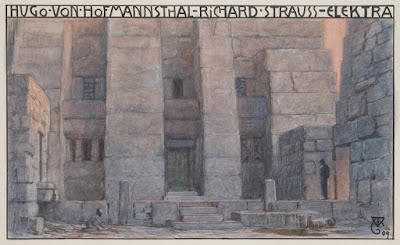 |
| Gwyneth Jones as Elektra |
It had a strong cast, with Gwyneth Jones in the title role, Helga Dernesch as Klytemnestra and conducted by Gerd Albrecht, and in fact they opened up some of the traditional cuts in the opera. But unlike WNO's modish production Covent Garden's staging dated from 1953 and had not been seen since 1977. Directed originally by Rudolf Hartman the production featured sets by Isabel Lambert which were not unlike those at the opera's first performance. It could have been a damp squib, but thanks to an incandescent performance from Gwynneth Jones, it was riveting. I got the impression that it was very much Jones' own performance, with a staff director simply indicating the traditional blocking.
This was a period when the Royal Opera always intended to mount a new production of Elektra, but this was long delayed. Götz Friedrich's new production finally arrived in 1990 with Eva Marton in the title role, and was revived in 1994 and 1997 before being in its turn replaced. In 1988, Gwyneth Jones, coming towards the end of her period as the house's dramatic soprano of choice, seemed to grasp the opportunity.
 |
| Alfred Roller's designs for the 1909 production of Richard Strauss' Elektra in Dresden |
Placido Domingo had famously said that he would not appear in the 1955 production, but the new one took such a long tme in coming (Elijah Moshinsky's new production appeared in 1987), that he relented and made his Covent Garden debut as Otello in 1980 conducted by Carlos Kleiber, returning in 1983 for the Wakhevitch production's final outing.
Georges Wakhevitch's designs for Otello were of a style that seemed to present problems to wardrobe for the costumes, as Wakhevitch was rather fond of blocks of colour and as costumes were replaced newer fabric stood out so there would be odd blocks of vibrant colour against the dull. This was something which was true of other productions such as Leslie Hurry's designs for Swan Lake (which originated in the 1950s).
There were a number of older productions where it was the sets themselves that were the problem. Both Luchino Visconti's production of Verdi's Il Trovatore, originally from 1964, which I saw in 1983 (with Jose Carreras and Katia Ricciarelli) and 1988 (with Jose Carreras and Elizabeth Connell), and Otto Klemperer's production Beethoven's Fidelio, originally from 1961, which I saw in 1983 (with Linda Esther Gray and Jon Vickers) had parts of the backdrops omitted and replaced by the cyclorama, presumably to lighten the look. And Rudolph Hartmann's 1969 production of Die Meistersinger was revived in 1990 with an entirely new set for the last scene (Michael Hopkins new designs replacing existing ones by Barry Kay).
By contrast, Filippo Sanjust's production of La Sonnambula (originally from 1960 which I saw in 1981 with Ileana Cotrubs) was meant to look old fashioned, and we were certainly not impressed.
Magnificent though the production of Don Carlos was, the extreme perspective of the sets, particularly in Act Four, made the view from the Amphitheatre very strange indeed and Philip's bedroom always seemed in need of a good dust.
Wozzeck which I saw in 1984, featured designs by Casper Neher from 1952. Neher had had a long working relationship with Brecht and he had originally designed the opera back in 1929. And the 1958 production of Poulenc's Carmelites was revived in 1983 with the original director, Margherita Wallman, present. That revival had a terrific cast which included Felicity Lott, Valerie Masterson, Regina Crespin and Pauline Tinsley, conducted by Michel Plasson.
Other notable productions that we saw included Visconti's 1967 production of Verdi's La Traviata with its Aubrey Beardsely inspired sets (stunning in the party scenes, less so in others) which we saw in 1985 with Ileana Cotrubas, Rudolf Hartman's 1965 production of Richard Strauss' Arabella which lasted until 1997 and which we caught in 1990 with Kiri Te Kanawa, and Visconti's 1966 production of Der Rosenkavalier which lasted until 1980 when we saw it with Gwyneth Jones, Yvonne Kenny and Yvonne Minton, conducted by Andrew Davis.
It wasn't all old though. Elijah Moshinsky whilst still a staff director had demonstrated with his production of Peter Grimes in 1975 (replacing one from 1953) and Lohengrin in 1977 (replacing one from 1963) that a new production could be mounted for what it cost to revive one of the older, more massive productions.




%20and%20kids.jpg)
.webp)





.jpg)
No comments:
Post a Comment